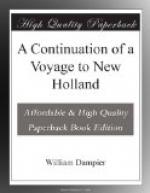Trees full of worms found in the sea.
Steering away from Cave’s Island south-south-east we found a strong current against us, which set only in some places in streams; and in them we saw many trees and logs of wood which drove by us. We had but little wood aboard; wherefore I hoisted out the pinnace and sent her to take up some of this driftwood. In a little time she came aboard with a great tree in a tow, which we could hardly hoist in with all our tackles. We cut up the tree and split it for firewood. It was much worm-eaten and had in it some live worms above an inch long, and about the bigness of a goose-quill, and having their heads crusted over with a thin shell.
St. John’s island.
After this we passed by an island called by the Dutch St. John’s Island, leaving it to the north of us. It is about 9 or 10 leagues round and very well adorned with lofty trees. We saw many plantations on the sides of the hills, and abundance of coconut-trees about them; as also thick groves on the bays by the seaside. As we came near it 3 canoes came off to us but would not come aboard. They were such as we had seen about the other islands: they spoke the same language, and made the same signs of peace; and their canoes were such as at Cave’s Island.
The mainland of new guinea.
We stood along by St. John’s Island till we came almost to the south-east point; and then, seeing no more islands to the eastward of us, nor any likelihood of anchoring under this, I steered away for the main of New Guinea; we being now (as I supposed) to the east of it, on this north side. My design of seeing these islands as I passed along was to get wood and water, but could find no anchor-ground, and therefore could not do as I purposed. Besides, these islands are all so populous that I dared not send my boat ashore unless I could have anchored pretty nigh. Wherefore I rather chose to prosecute my design on the main, the season of the year being now at hand; for I judged the westerly winds were nigh spent.
Its inhabitants.
On the 8th of March we saw some smokes on the main, being distant from it 4 or 5 leagues. It is very high, woody land, with some spots of savannah. About 10 in the morning 6 or 7 canoes came off to us: most of them had no more than one man in them; they were all black, with short curled hair; having the same ornaments in their noses, and their heads so shaved and painted, and speaking the same words, as the inhabitants of Cave’s Island before mentioned.
The coast described.
There was a headland to the southward of us beyond which, seeing no land, I supposed that from thence the land trends away more westerly. This headland lies in the latitude of 5 degrees 2 minutes south, and meridian distance from Cape Mabo 1290 miles. In the night we lay by for fear of over-shooting this headland. Between which and Cape St. Maries the land is high, mountainous and woody; having many points of land shooting out into the sea, which make so many fine bays. The coast lies north-north-east and south-south-west.




